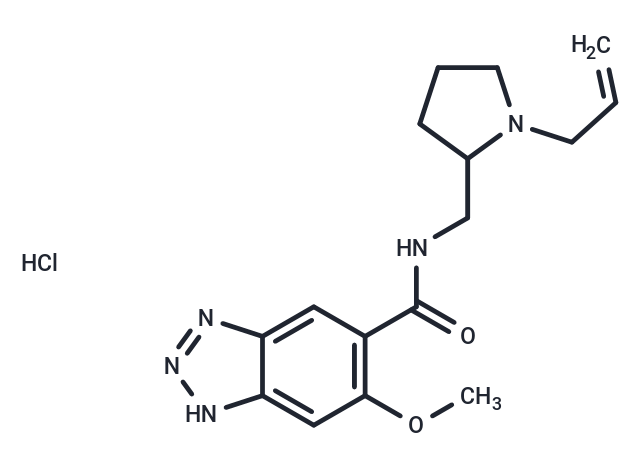Shopping Cart
- Remove All
 Your shopping cart is currently empty
Your shopping cart is currently empty
Alizapride hydrochloride (Alizapride HCl) is a dopamine receptor antagonist used for the treatment of nausea and vomiting.

| Pack Size | Price | Availability | Quantity |
|---|---|---|---|
| 25 mg | $30 | In Stock | |
| 50 mg | $42 | In Stock | |
| 100 mg | $68 | In Stock | |
| 500 mg | $163 | In Stock | |
| 1 mL x 10 mM (in DMSO) | $39 | In Stock |
| Description | Alizapride hydrochloride (Alizapride HCl) is a dopamine receptor antagonist used for the treatment of nausea and vomiting. |
| In vitro | Intravenous administration of 5 mg/kg Alizapride in rats effectively counteracts the reduction in gastrointestinal motility induced by the given dose of Apomorphine. Alizapride exhibits low toxicity in mice and rats, particularly when administered extragastrically. Following oral or extragastric administration, Alizapride is primarily excreted in its unmodified form; however, approximately 25% of Alizapride undergoes metabolic transformation before excretion. |
| In vivo | Alizapride contains an N-allyl moiety, which may undergo N-deallylation and/or epoxidation, potentially leading to the formation of chemically reactive metabolites. |
| Synonyms | Alizapride HCl |
| Molecular Weight | 351.83 |
| Formula | C16H21N5O2·HCl |
| Cas No. | 59338-87-3 |
| Smiles | Cl.COc1cc2[nH]nnc2cc1C(=O)NCC1CCCN1CC=C |
| Relative Density. | 1.224 g/cm3 |
| Storage | Powder: -20°C for 3 years | In solvent: -80°C for 1 year | Shipping with blue ice/Shipping at ambient temperature. | |||||||||||||||||||||||||||||||||||
| Solubility Information | H2O: 50 mg/mL (142.11 mM), Sonication is recommended. Ethanol: < 1 mg/mL (insoluble or slightly soluble) DMSO: 40 mg/mL (113.69 mM), Sonication is recommended. | |||||||||||||||||||||||||||||||||||
Solution Preparation Table | ||||||||||||||||||||||||||||||||||||
DMSO/H2O
| ||||||||||||||||||||||||||||||||||||

Copyright © 2015-2025 TargetMol Chemicals Inc. All Rights Reserved.